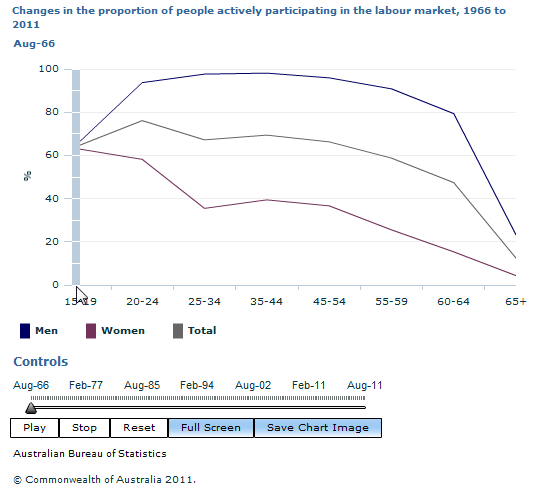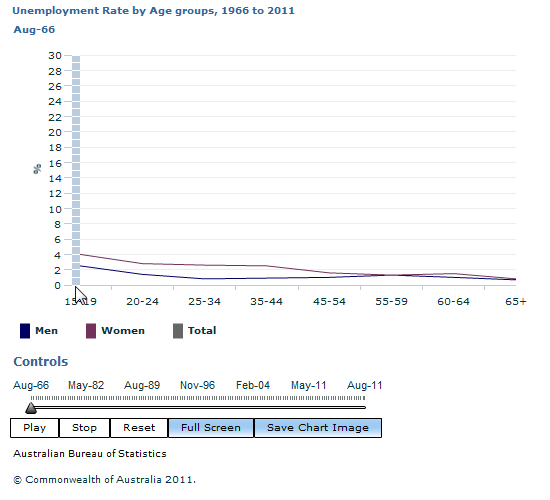6291.0.55.003 - Labour Force, Australia, Detailed, Quarterly, Aug 2012  Quality Declaration
Quality Declaration
ARCHIVED ISSUE Released at 11:30 AM (CANBERRA TIME) 13/09/2012
Page tools:
 Print Page Print Page
 Print All Print All
| ||||
|
UNDERSTANDING THE AUSTRALIAN LABOUR FORCE USING ABS STATISTICS In order to understand what is happening in Australian society, or our economy, it is helpful to understand people’s patterns of work, unemployment and retirement. ABS statistics can help to build this picture. Fifty years ago, the majority of Australians who worked were men working full-time. Most worked well into their 60s, sometimes beyond, and if they were not working most were out looking for work until that age. The picture now is very different. Far more people work part-time, or in temporary or casual jobs. Retirement ages vary much more, with a greater proportion of men not participating in the labour force once they are older than 55. Nowadays, 45% of working Australians are women, compared with just 30% fifty years ago. These are profound changes that have helped shape 21st Century Australia. This note explains some of the key labour force figures the ABS produces that can be used to obtain a better picture of the labour market.  Source(s): Labour Force, Australia, Detailed - Electronic Delivery (cat. no. 6291.0.55.001); Labour Force Historical Timeseries, Australia (cat. no. 6204.0.55.001) Every month, the ABS runs a Labour Force Survey across Australia covering almost 30,000 homes as well as a selection of hotels, hospitals, boarding schools, colleges, prisons and Indigenous communities. Apart from the Census, the Labour Force Survey is the largest household collection undertaken by the ABS. Data are collected for about 60,000 people and these people live in a broad range of areas and have diverse backgrounds - they are a very good representation of the Australian population. From this information, the ABS produces a wide variety of statistics that paint a picture of the labour market. Most statistics are produced using established international standards, to ensure they can be easily compared with the rest of the world. The ABS has also introduced new statistics in recent years that bring to light further aspects of the labour market. It can be informative to look at all of these indicators to get a grasp of what is happening, particularly when the economy is changing quickly. One thing to remember about the ABS labour force figures is that when a publication states that, for example, 11.4 million Australians are employed, the ABS has not actually checked with each and every one of these people. In common with most statistics produced, the ABS surveys a sample of people across Australia and then scales up the results – based on the latest population figures - to give a total for the whole country. Because the figures are from a sample, they are subject to possible error. The Labour Force Survey is a large one, so the error is minimised. The ABS provides information about the possible size of the error to help users understand how reliable the estimates are. CONTENTS The above diagram shows the break down of the civilian population into the different groups of labour force participation. Each pixel represents about 1000 people as at September 2011. EMPLOYMENT According to established international standards, everyone who works for at least one hour or more for pay or profit is considered to be employed. This includes everyone from teenagers who work part-time after school, to a partially retired grandparent working for pay at the school canteen. While it is unreasonable to expect a family to survive on the income of an hour of work per week, one could also argue that all work, no matter how small, contributes to the economy. This definition of 'one hour or more' - which is an international standard - means that ABS' employment figures can be compared with the rest of the world. Now it is, of course, easy to argue that someone who works 2 or 3 hours per week is not really “employed”, but a definition is required, and any cut-off point is open to debate. Imagine if ABS defined being ‘employed’ as working 15 hours a week. Would it be reasonable to argue that someone who works 14.5 hours is unemployed, but 15 hours is not? It is also a mistake to assume that all persons who work low hours would prefer to work longer hours, and are therefore 'hidden' unemployment. Most people who work less than 15 hours a week are not seeking additional hours, although of course there are some who are. The issue of underemployment is further discussed below. Rather than open up such discussions, the ABS prefers to use the international standard and the ABS also encourages people to consider other indicators to form a better picture of what is happening. Alongside the total employed figures, full-time and part-time estimates are provided to better inform on the different kinds of employment, and a detailed breakdown by the number of hours worked is also provided to allow for customised definitions of 'employment.' Commentators often refer to the rise in employment as the number of new jobs created each month. This can be misleading, because the ABS doesn't actually measure the number of jobs. This might sound like semantics, but if a person in the Labour Force Survey who is employed gains a second part-time job at the same time as their main job, this would have no impact on the employment estimate - the Labour Force Survey does not count jobs, it counts people. It is also important to bear in mind that if the relative growth in population is greater than the number of new people in employment, there might actually be an increase in the employment figure, but a lower percentage of people with jobs. It is often informative to look at the proportion of people in employment. This measure, called the employment to population ratio, is the number of employed people expressed as a percentage of the civilian population aged over 15. This removes the impact of population growth to give a better picture of labour market dynamics over time. AGGREGATE MONTHLY HOURS WORKED Instead of counting how many people are working, another way of looking at how much Australians are working is to count the total number of hours worked by everyone. This is measured by a statistic produced by the ABS called Aggregate monthly hours worked, and it is measured in millions of hours. This can sometimes be more revealing of what is happening in the labour market, particularly in a weakening economy where a fall in hours worked can usually be seen before any fall in the number of people employed. PEOPLE WHO ARE NOT WORKING: THE UNEMPLOYED AND OTHERS There are many reasons why Australians do not work. Some have retired and are not interested in going back to work. Some are staying home to look after children and plan on going back to work once the kids have grown older. Some are out canvassing for work every day while others have given up looking. The ABS separates all of these people into those who are unemployed and those who are not by asking two simple questions: If you were given a job today, could you start straight away? and Have you taken active steps to look for work? Only those who are ready to get back into work, and are taking active steps to find a job, are classed as unemployed. Some people might like to work, but are not currently available to work - such as a parent who is busy looking after small children. Other people might want to work but have given up actively looking for work - such as a discouraged job seeker who only half-heartedly glances at the job adds in the newspaper but doesn't call or submit any applications. These people are not considered to be unemployed, but are regarded as being marginally attached to the labour force. They can be thought of as 'potentially unemployed' when, or if, their circumstances change, but are regarded as being on the fringe of labour force participation until then. It is important to note that the ABS unemployment figures are not the same as the data that Centrelink collects on the number of people receiving unemployment benefits. The ABS bases its figures on asking people directly about their availability and steps to find work. In this way, policy decisions about, for example, the criteria for the receipt of unemployment benefits have no impact on the way that the unemployment figures are measured. LABOUR FORCE AND PARTICIPATION RATE The size of the labour force is a measure of the total number of people in Australia who are willing and able to work. It includes everyone who is working or actively looking for work - that is, the number of employed and unemployed together as one group. The percentage of the total population who are in the labour force is known as the participation rate. UNEMPLOYMENT RATE The unemployment rate is the percentage of people in the labour force who are unemployed. This is a popular measure around the world for tracking a country’s economic health as it removes all the people who are not participating (such as those who are retired). Because the unemployment rate is expressed as a percentage, it is not directly influenced by population growth.  Source(s): Labour Force, Australia, Detailed - Electronic Delivery (cat. no. 6291.0.55.001); Labour Force Historical Timeseries, Australia (cat. no. 6204.0.55.001) UNDEREMPLOYMENT RATE The underemployment rate is a useful companion to the unemployment rate. Instead of looking at the people who are unemployed, the underemployment rate captures those who are currently employed, but are willing and able to work more hours. It highlights the proportion of the the labour force who work part-time but would prefer to work full-time. This is sometimes referred to as the 'hidden' potential in the labour force. The underemployment rate can be an important indicator of changes in the economic cycle. During an economic slow down, some people lose their jobs, become unemployed and contribute to a rising unemployment rate. But while this is happening, there might well be others who remain working but have their hours reduced, for example from full-time to part-time. As long as they want to work more hours, they are classed as underemployed, and contribute to the underemployment rate. LABOUR FORCE UNDERUTILISATION RATE The labour force underutilisation rate combines the unemployment rate and the underemployment rate into a single figure that represents the percentage of the labour force that is willing and able to do more work. It includes people who are not currently working and want to start, and those who are currently working but want to - and can - work more hours. It provides an alternative – and more complete - picture of labour market supply than the unemployment rate, as changes in the underutilisation rate capture both changes in unemployment and underemployment, indicating the spare capacity in the Australian labour force. FURTHER INFORMATION For any queries regarding these measures or any other queries regarding the Labour Force Survey estimates, contact Labour Force on Canberra 02 6252 6525, or via email at labourforce@abs.gov.au. Document Selection These documents will be presented in a new window.
|
|||
